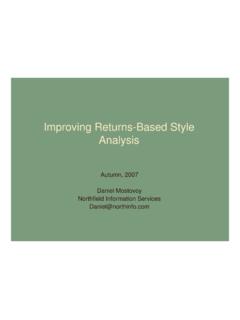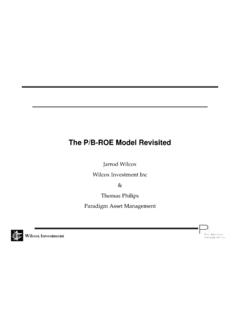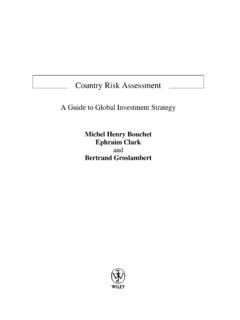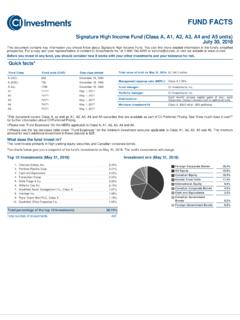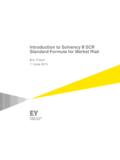Transcription of Northfield US Fundamental Risk Model
1 FUNDAMENTALE quity Risk ModelNORTHFIELDIDENTIFY ANALYZE Fundamental Equity Risk Model 1 Table of Contents INTRODUCTION .. 2 BASIC CONCEPTS .. 2 Risk and Return .. 2 Idiosyncratic Risk .. 2 Systematic Risk .. 2 Diversification of Risk .. 2 Multiple Factor Models .. 3 Model OVERVIEW .. 4 Basics .. 4 Description of the Fundamental Model .. 4 Estimation .. 5 Beta from fundamentals .. 5 Factor Alphas .. 6 Exponential Weighting for Factor Variance and Covariance Estimation .. 7 Conditional Mean Returns for Factor Variance and Covariance Estimation .. 7 Asset Specific Risk Adjustment Using Parkinson Volatility Estimator .. 8 Model as Basis for Historic Performance Attribution .. 8 FACTOR DEFINITIONS.
2 9 Earnings/Price .. 9 Book/Price .. 9 Dividend Yield .. 9 Trading Activity .. 9 12-Month Relative Strength .. 9 Logarithm of Market Capitalization .. 9 Earnings Variability .. 9 EPS Growth Rate .. 9 Revenue/Price .. 9 Debt/Equity .. 9 Price Volatility .. 9 THE DATA FILE .. 10 FEB-3-2015 Fundamental Equity Risk Model 2 The Northfield Fundamental Model is a multi-factor risk Model designed to help US equity managers control portfolio exposure to endogenous factors such as price-to-earnings ratios and yield.
3 It is a relaxed CAPM construct: while acknowledging the importance of Beta in measuring the risk of a portfolio, it goes further to include other variables in capturing sources of covariance between securities. The Model is based on 67 factors (66 plus Beta), 55 of which are industry dummy variables. It is fully compatible with the Northfield Open Optimizer. This booklet introduces the Model with a short discussion of the basic concepts underlying the risk Model , followed by a description of the process by which the Model is estimated. A list of the factors used in the Northfield Fundamental Model , their definitions, and means by which they are derived is also included.
4 The structure of the data file, where the coefficients of the Model are stored, is shown at the end. The positive relationship between risk and expected return is one of the most basic concepts of investment theory. Modern portfolio theory says, however, that only that risk which is undiversifiable in aggregate should increase expected return. The risk associated with any investment can be broken into two parts: the idiosyncratic (or unsystematic) risk, which is diversifiable, and the systematic risk, which may not be diversifiable. The idiosyncratic risk associated with a holding in any one security is the risk that is particular to that one investment. If the investment is common stock, idiosyncratic risk can come from management decisions, or anything else that changes the fortunes of one company but does not affect the fortunes of other companies.
5 Systematic risk arises from factors which affect the returns of virtually all securities in the market. For example, a rise in the level of interest rates will increase bond yields, thus providing investors with an alternative investment vehicle to equities. This, in turn, will lower the demand for stocks, and, ceteris paribus, drive the prices of stocks down. Idiosyncratic risk (security specific) can be diversified away simply by having many different securities in a portfolio. For example, which is the winner in a lawsuit brought by one corporation against another is a risk that ordinarily is borne only by the investors in one company or the other and is therefore a specific, or unsystematic risk.
6 That risk does not manifest itself for the entire portfolio; the wealth of all investors together will not be affected by which company wins the lawsuit, since the other company must pay what the first company wins. A portfolio that bears this risk should not be expected to earn extra return from bearing the risk of the lawsuit, because the risk may be diversified away by buying stock in both companies. The portfolio that includes only one of those companies is therefore an inefficient bearer of Introduction Basic Concepts Risk and Return Idiosyncratic Risk Systematic Risk Diversification of Risk Fundamental Equity Risk Model 3 risk; that is, it is bearing risk without being compensated for that risk.
7 Theoretically, the net risk that any one investment contributes to a well-diversified portfolio may be measured by the covariance of the investment s return with the return on the market portfolio. This risk is usually expressed as Beta, where the Beta of an investment is equal to the covariance of the investments returns with the markets returns, divided by the variance of the market A more complex way to measure portfolio risk than using a single index (Beta) is to apply many factors to estimate portfolio risk. In this framework return and risk are measured by a portfolio's exposure to multiple factors. There are several advantages of using multiple factor models over a single-index Model .
8 Economic logic is used in the development of multiple-factor models and selecting the appropriate factors, these models are not purely dependent on historical relationships. Multiple factor models allow for a more thorough understanding of a portfolio's exposure to different variables. Multiple factor models allow for analyses that are more precise, and lead to better-informed investment decisions. Multiple factor models are better equipped to deal with outliers. Mathematically, a multiple factor Model can be expressed as follows: = ,1 1+ + , + where ri = the return over the risk-free rate for company i bi,n = the price of factor n (the risk premium) for company i fn = the value of factor n ei = the stock-specific return for company i By describing each company's risk and return using a specific number of factors, the calculation of expected portfolio return and risk is greatly simplified.
9 The covariance matrix of all of the factors, and the securities' exposures to them can be used to estimate the expected return and variance of a 1 For more about this topic, refer to chapter 2 of Rudd, Andrew and Henry K. Clasing, Jr., Modern Portfolio Theory: The Principles of Investment Management, Orinda, CA, Andrew Rudd, 1988. 2 For a more complete discussion of this topic, please refer to Rosenberg, Barr, "Extra-Market Components of Covariance in Securities Markets," Journal of Financial and Quantitative Analysis, March 1974, pp. 263-274. Edwin J. Elton and Gruber, Martin J., Modern Portfolio Theory and Investment Analysis, New York, John Wiley & Sons, Inc.
10 , 1991, Chapter 6 also deals with this subject matter. Multiple Factor Models Fundamental Equity Risk Model 4 The Northfield US Fundamental Equity Risk Model uses security and company characteristics (such as P/E or industry classification) that are observable about each security to gauge the level of similarity between two stocks and hence their likely degree of covariance. It is an endogenous multiple factor Model of the behavior of US common stocks. The dataset for the Fundamental Model provides information on approximately 5000 US companies including several hundred major ADRs. The Model estimation is done at month end.




